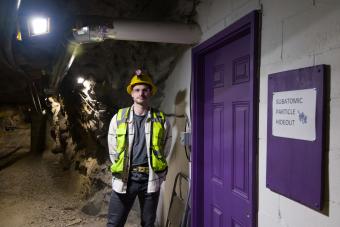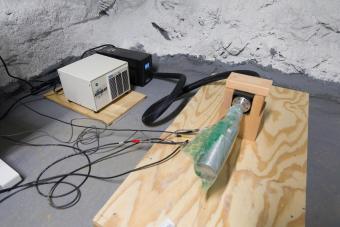Colorado School of Mines is developing a quantum research lab inside a literal mine
CURIE – short for Colorado Underground Research Institute – will allow researchers to test quantum sensors and more in very low background environment

Physics PhD student Dakota Keblbeck adjusts a scintillator in a photomultiplier tube inside the Subatomic Particle Hideout at Edgar Experimental Mine. Keblbeck’s work is helping to demonstrate the viability of running future quantum experiments at Edgar.
By John Himes, Special to Mines Newsroom
Colorado School of Mines is known for both cutting-edge research and its historical roots supporting Colorado’s mining industry. Now these two worlds are coming together in a new way.
Mines is developing a quantum research facility inside the Edgar Experimental Mine in Idaho Springs to serve as a testbed for experiments that will push the boundaries of fundamental science and support quantum technology commercialization by industry.
Named the Colorado Underground Research Institute (CURIE), the facility is a joint effort of the Departments of Mining Engineering and Physics at Mines in support of the university’s participation in Elevate Quantum, a Mountain West consortium that was awarded $127 million in federal and state funding in 2024 with the mission to secure the U.S.’s lead in quantum technology. Once fully developed, both academic institutions and private companies who are members of Elevate Quantum will be able to use the unique underground facilities.
“The establishment of CURIE deep inside the Edgar Experimental Mine will allow researchers to test very sensitive equipment such as quantum sensors and devices in a very low-background environment, shielded from cosmic rays and electromagnetic noise prevalent at the surface,” said Fred Sarazin, professor and head of the Physics Department at Mines. “This is such an incredible resource to have right here in Colorado – when we tell scientists and engineers that we are building a quantum lab in a mine, we have their immediate attention.”
Infrastructure work is already underway to prepare the mine for the installation of instruments, with the goal of having the first quantum laboratory in CURIE fully instrumented and operational by the end of 2026. The Mining Engineering Department at Mines is preparing the tunnels and chambers as well as providing operational support to the project. The Physics Department will outfit the facility with lab equipment and run the experiments.
"The Edgar Experimental Mine is just as vital today as an underground laboratory for research and training ground for future engineers as it was during its heyday as an operational gold, silver and copper mine,” said Bill Zisch, J. Steven Whisler Chair for the Head of Mining Engineering. “For years, this unique underground environment has provided students with an unparalleled hands-on experience in mining techniques and systems, while also serving as a one-of-a-kind laboratory for cutting-edge research. From traditional mining engineering to emerging fields like robotics—and now quantum technology — the Edgar Mine continues to push the boundaries of what’s possible below the surface. The Mining Engineering Department is excited to partner with our colleagues in the Physics Department to bring the new CURIE facility to life and welcome quantum scientists, engineers and entrepreneurs underground.”

Welcome to the Subatomic Particle Hideout
The history of the Edgar Mine goes back to the Colorado gold rush in the 19th century. In the 1870s, the commercial mine produced high-grade silver, gold, lead and copper.
Colorado School of Mines began leasing the property in 1921 and later acquired it for use as an underground classroom and engineering education facility for training mining engineers.
Walk into the tunnels today and that legacy is apparent: Heavy equipment, both historical and modern, is parked throughout, blasting holes dot the walls and cartloads of ore stand ready for removal.
But keep walking and about a quarter mile in you’ll come across a bright purple door. A sign featuring Blaster the Burro reads “SUBATOMIC PARTICLE HIDEOUT.”
Open the door and you’ll find Dakota Keblbeck, a PhD student in physics, hunched over the plastic scintillators and photomultiplier tubes he’s using to perform measurements to characterize the ability for the dense rock to block cosmic radiation from entering the lab space. These devices are designed to produce and capture light when radiation – a muon, for example – interacts with them, allowing Keblbeck to establish a baseline for the background radiation in the environment. This is crucial because that ambient noise can interfere with sensitive detectors and measurements that are planned for the facility.
Keblbeck is a member of the research group of Kyle Leach, associate professor of physics and science director of CURIE. Leach’s Electroweak Interactions Group primarily focuses on performing precision measurements of nuclear decay to probe the fundamental interactions of nature.
Keblbeck’s work in the mine is proof of concept for more work to come. By preparing the environment in this chamber to be even more isolated than the rest of the mine, Leach’s team, along with Physics Assistant Professor Eric Mayotte and Professor Uwe Greife, technical director of CURIE, are demonstrating the viability of running future quantum experiments at Edgar.
At the same time, Keblbeck is laying valuable groundwork, such as understanding the topology of the mountain overhead and the mineral composition of the rock walls surrounding the lab, all of which can affect the performance of quantum technologies.
“The characterization work we’re doing is crucial for establishing this facility as a low-background laboratory,” Keblbeck said.

A Rare and Valuable Resource
The Subatomic Particle Hideout is only the beginning of the work for CURIE. Excavation is underway for a larger chamber that will constitute CURIE’s first quantum lab and there are plans to construct additional labs in the future.
Once ready, Wouter Van De Pontseele, a new assistant professor of physics, will use this laboratory space to develop advanced sensing technologies to study neutrinos. While the initial experiments are focused on fundamental science to understand the fabric of the Universe, CURIE will eventually host both academic and industry projects.
“The sensitivity required to perform our fundamental science measurements have reached the level where facilities such as CURIE become important,” Leach said.
Part of the applied science work that is an extension of this, led by Van De Pontseele, is to determine whether quantum computers will perform better underground. Quantum technology is limited by how long it can maintain a state called quantum coherence, and today’s most sophisticated computers measure quantum coherence times in milliseconds. Operating in these low-background environments may prove beneficial to increasing that coherence time by simply moving these devices to places like CURIE.
“This is a rare and valuable resource,” Leach said. “There are only a handful of other similar underground labs in the world, and many are restrictive, difficult to access and expensive.”




